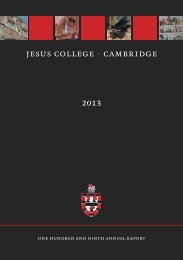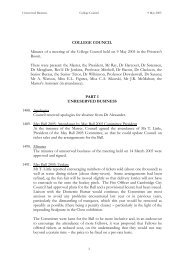2012 Annual Report - Jesus College - University of Cambridge
2012 Annual Report - Jesus College - University of Cambridge
2012 Annual Report - Jesus College - University of Cambridge
Create successful ePaper yourself
Turn your PDF publications into a flip-book with our unique Google optimized e-Paper software.
38 MEMOIR I <strong>Jesus</strong> <strong>College</strong> <strong>Annual</strong> <strong>Report</strong> <strong>2012</strong><br />
scouting the immediate surroundings for<br />
leads through the ice, and reading the sky for<br />
darker shades where there may be distant<br />
open water. Sometimes we used pick axes<br />
ahead <strong>of</strong> the ship and – what was much more<br />
fun – dynamite. After several days in the pack<br />
we became beset near 77°S. It was the<br />
furthest south Shackleton had reached, on<br />
this same course, locked in the ice from<br />
which he never recovered the ship. Our<br />
instructions from the Royal Society read:<br />
‘find a site for a fixed observatory south <strong>of</strong> 75°<br />
in the Vahsel Bay area <strong>of</strong> the Weddell Sea’.<br />
So no time was lost in setting out extra<br />
charges <strong>of</strong> dynamite to gain our release from<br />
the ice and to turn back north, searching the<br />
coastline for a landing site.<br />
Pack ice, is the frozen surface <strong>of</strong> the sea<br />
comprising floes, large and small, with<br />
occasional leads <strong>of</strong> open water where the floes<br />
part, or pressure ridges where compressive<br />
forces bring the floes together. The outer<br />
parts <strong>of</strong> the pack break up in the summer,<br />
drift north, and melt. Sea ice which is several<br />
years old may be many metres thick and, if<br />
attached to the ‘land’, is known as fast ice.<br />
Falling snow inland, on the continent,<br />
compacts over many years, forming firn, and<br />
reaching depths in the Antarctic which<br />
completely obliterate the topography <strong>of</strong> the<br />
native rock. Then the gradual discharge <strong>of</strong> the<br />
ice from the centre <strong>of</strong> the continent to the<br />
coastline is on a very broad front in the form<br />
<strong>of</strong> an ice sheet which thins as it creeps towards<br />
the coast. If this sheet floats out over the sea,<br />
as much <strong>of</strong> it does in Antarctica, it is known













